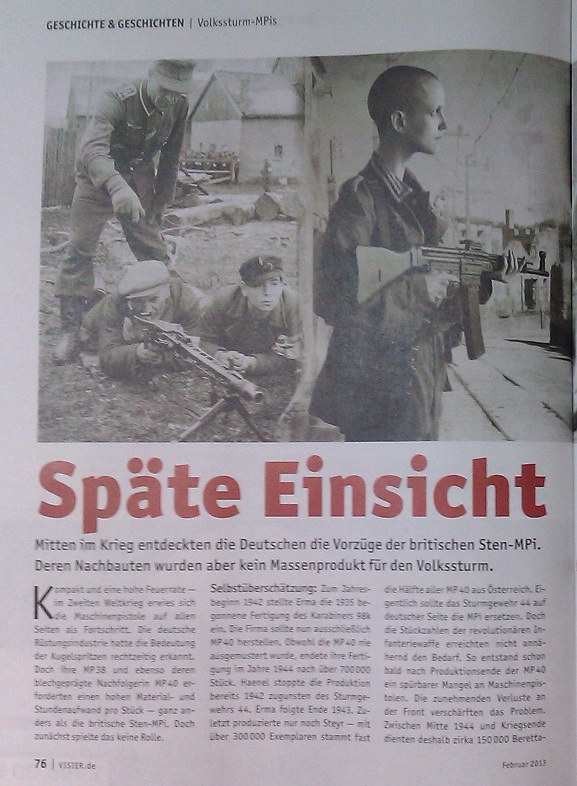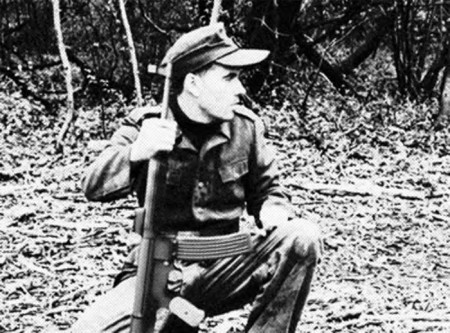The internet is an amazing tool – I truly believe the revolution in communications it has ushered in is one of the pivotal paradigm shifts in human history. It has eliminated geographic restrictions on sharing information, and thus allowed anyone worldwide to learn about the most specific niche subjects conceivable. However, that doesn’t mean it’s perfect. While the ‘net allows us access to massive volumes of data, it does nothing inherently to sort or verify that data. A rumor that could spread across a town in years previous can travel the globe in hours now.
In our field of historical arms research, the problem has existed for a while. A good example is the Cei Rigotti rifle – someone long ago wrote the first bit of literature on them, and simply assumed that being Italian, they must have been chambered for 6.5 Carcano. Turns out they aren’t – but since there are very few around to actually look at, everyone too that first guy’s mistake as gospel, and it has been repeated in every description of the gun ever since.
With our technical ability to tinker with photos, we are going to see this turning up with fake historical photos too – in fact, we already are. For example, here’s a scan of an article on the Volkssturm from the February 2013 edition of Vizier magazine in Germany:

That photo on the right of the Volkssturm with the StG? That was taken in 2012 by my friend Oleg Volk, with an ATI .22-caliber StG, and the background added digitally (you can see the original posting here: A good fight in a bad cause). It looks pretty dang real, and clearly the editors at Vizier didn’t take the time to ensure it was authentic.
Here’s another example that comes up from time to time (although I haven’t seen it in a print publication yet):

The fellow in this photo created it as a fun project. The rifle (a prototype StG-45M) is a 3D computer model that he created and digitally added into the picture. You can see him commenting on it here on the AxisHistory forum: 7.92mm StG45-MP-45.
Neither of these images was created with any intent of passing them off as historically authentic photos – but it is easy for things to be reposted a couple times and take on completely new titles and descriptions, thanks to the internet. When looking for sources on the ‘net, we always need to be careful to check out the origins of photos and information, so we can avoid making these sorts of mistakes. At the same time, this is a good reason to learn the little details of things, so we can spot when a photo or datum is inconsistent, and be able to better sort truth from rumor and fiction.
Neither

This all reminds me of that frankly shameful report on the IRA by ITV that used footage from a videogame.
http://www.youtube.com/watch?v=cQuglSbXeVo
Granted, it was a very realistic videogame that I am rather fond of, but quite literally it revealed that the quality of research was some guy googling it.
A good example of this in the print world is the infamous “AKMSU” which often shows up in many AK reference books and described as an early AKS-74U Russian prototype. Even though it gets reprinted pretty regularly it’s been thoroughly debunked as a chinese franken-ak.
My pet peeve is the American tendency to call the 8×57 IS a JS. It’s understandable where it came from, the German fraktur I and J both look like a J, and many print publications from the late 19th century use the same actual letter. But it started out as 8×57 Infantrie cartridge, spelled with an I just like the US Infantry.
i bought a k98 mauser carbine [brand new] around 1967 complete with bayonet and 4 ammo pouches,around that time Norma produced some sporting ammo with the designation 8x57js and with various bullet weights which turned my k98 into an awesome hunting rifle with great knock down power! i see your point,as the js was clearly printed on the cartridge box!
Opinion manipulation is big and all pervasive on net. It does not know limitations and originators of false news know that. When comes to firearms what bothers me specifically are those who create ‘combat-games’ versions; but I learned to discern them. They are rarely true to riginals.
Mu – Actually, I and J are in many cases interchangeable in German viz the spa town of Idar-Oberstein which is ofter written as Jdar-Oberstein.
Seperate point : Beware of fakers getting photos of bogus guns into reference books with a view to “creating authenticity” !
The same pitfalls also occur when doing research and quoting otherwise reliable sources in print. Ruy Aballe and I had an interesting discussion about this concerning the Brazilian Uirapuru GPMG in the “Comments” section of the “Mondragon Model 1894” article posted on 010413.
First things first: I have contacted Michael, the hapless author of the German Sten article in question, to find him distraught and angry about the decision by anonymous idiot layout graphic to “spice” his article with uncalled for photos – much more so at the expense of photos pertaining to the subject. Unfortunately, sometimes in printed press the author who fronts the article with his name does not necessarily control the whole production process. The magazine in question, Visier, is one of the Germany’s largest gun magazines, and someone out there probably decided they know better what would be selling best.
I run a hardcopy gun magazine (STRZAL) here in Poland for 10 years now, and I know all about that urge – even if I always believed in meritocracy, and try (sometimes desperately) not to fall for such practices.
Now, the “I Know Better What It’s Called” syndrome is not a recent idea – let me just remind you of the ‘Schmeisser’ name being used in conjunction with the MP.38 and 40, which were no Schmeisser designs at all, but a Frankenstein monster cobbled together by the Land Forces Armament Bureau (HWA). Yet, the American writers knew better 🙂
Same thing with many other guns. It was – AFAIR – Paul Scarlata who christened the modified 31M Hungarian Mannlicher rifle a ‘Hugazol’. Well, the Hungarian name for a rifle is a Puska, and not Hugazol – but ever since Scarlata’s ‘Military Mannlichers’ book, the Hungarian rifles are called Hugazol all over the Net.
Another example, closer to my heart: Polish Kalashnikovs called PMKM, and grenade-launching version called the PMK-DGN – up until 1990s. There were simply no such beasts, ever. Early on, the AK in Polish army was not deemed a rifle, but a submachine gun (East Germans still had their MPiK-74s when the Wall collapsed in 1989). Thus the designation was according to the then used practice “pistolet maszynowy Kałasznikowa (pmK)” – not all capital letters, mind you, only the last one. In 1967, when stamped AKM replaced the milled AK in Radom’s production, some bright mind at the General Staff decided to call the AK a ‘carbine’ – since then the Polish name was ‘karabinek automatyczny Kałasznikowa (kbk AK)’ and ‘kbk AKM’. But Jane’s Small Arms knew better – and taking example from East German MPiKM, they created a ‘PMKM’, which never existed. The grenade-launching capable AK was in Polish nomenclature the kbk-g wz.60 and wz.60/72 (a paratroop model with detachable stock) – but the Americans knew better: DST-1110H-394-76 Small Arms Identification and Operation Guide – Eurasian Communist Countries introduced a spurious designation of PMK-DGN – and so it was called for over 30 years! BTW – this DGN means ‘dymny granat nasadkowy’ or rifle smoke grenade… So, someone knew the bell tolled (something connected with rifle grenades capability) – but failed to guess at which church.
And now finally my pet pev – the ‘AK-47’ moniker. Believe it or not, but AK-47s were never mass-produced. The AK-47 was a prototype stage (between AK-46 and AK-48) of the AK rifle, an important stepping stone and a model to be followed by other prototypes, but NOT a final modification. The weapon introduced in 1949 was not an AK-47, but just an AK – and it had a stamped receiver (the so-called AK-47 1st Model). It’s short-time milled successor (AK-47 2nd Model) was also called AK, and the final milled variation was introduced as an OAK – Lightened AK. Does no matter, the Americans knew better – it’s ‘AK-47, 3rd Model.
Then in 1959 another model replaced the ‘milled AK-47’ – the AKM, re-introducing stamped receiver. And again the Americans knew better it should be called ‘AK-47 stamped’. This AK-47 craze was so much stamped into people’s minds, that even the Russians started to use the moniker – even though the only AK with digits in Soviet times was the AK-74, called so to differentiate it immediately from the AKM, using no numerals at all.
OK, enough – I could go on with this rant for days upon end… There are so many other guns misnamed, this discussion can go forever.
Those damned Americans, always renaming stuff whenever they want…
Sincerely,
Tamara K(ielminski) :p
David, it’s still an I, pronounced as I, and no one in Germany would mistake it for a J, even if the font looks like it. You might also be confused by the German cursive I which looks like a Times Roman J, while the German cursive J has a loop underneath.
The designation is indeed 8x57IS. But keep in mind that this name is from the gun trade and was introduced after World War I. The German army never used it.
Leszek’s highly-informative comment in this post should be made general information on the Internet, if for nothing else at least for the sake of establishing truth and accuracy.
Interesting about the mp 38&40, publications show that while schmeiser designed the M.P. 18 and later on the M.P.41,he had no part in the design of the M.P.40 that bears his name,perhaps as the head designer of haenal he had the authority to name it Schmeiser,who would object??